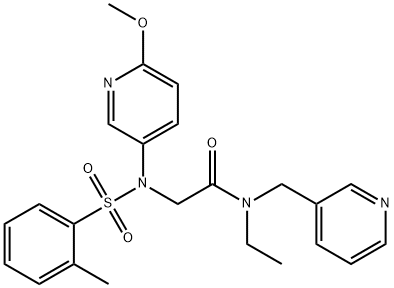680590-49-2
 680590-49-2 結(jié)構(gòu)式
680590-49-2 結(jié)構(gòu)式
基本信息
N-ETHYL-2-[(6-METHOXYPYRIDIN-3-YL)-(2-METHYLPHENYL)SULFONYLAMINO]-N-(PYRIDIN-3-YLMETHYL)ACETAMIDE
N-Ethyl-2-[(6-methoxy-3-pyridinyl)[(2-methylphenyl)sulfonyl]amino]-N-(3-pyridinylmethyl)-acetamide
Acetamide, N-ethyl-2-[(6-methoxy-3-pyridinyl)[(2-methylphenyl)sulfonyl]amino]-N-(3-pyridinylmethyl)-
物理化學(xué)性質(zhì)
常見問題列表
|
OX 2 Receptor
|
EMPA competitively antagonizes orexin-A-and orexin-B-evoked accumulation of [
3
H]inositol phosphates (IP) at hOX
2
receptors with pA
2
values of 8.6 and 8.8 respectively.
EMPA displaces the [
3
H]EMPA binding from cell membranes containing human and rat OX
2
receptors, with K
i
values of 1.10±0.24 nM and 1.45±0.13 nM, respectively.
EMPA shows an IC
50
=5.75 μM, K
i
=2.63 μM, and IC
50
=12.8 μM, K
i
=5.8 μM in the binding assay at human and mouse V
1a
receptors, respectively.
In CHO(dHFr
-
) cells stably expressing hOX
2
receptors, EMPA inhibits orexin-A-or orexin-B-evoked [Ca
2+
]
i
response with IC
50
s of 8.8±1.7 nM and 7.9±1.7 nM, respectively.
EMPA (1-300 mg/kg; i.p.) dose-dependently reverses this [Ala
11
,D-Leu
15
]orexin-B-induced hyperlocomotion without itself significantly affecting locomotor activity (LMA) in male NMRI mice.
EMPA (3-30 mg/kg; i.p.) induces a significant and dose-dependent reduction in the baseline LMA in france and male Wistar rats. EMPA (3-30 mg/kg; i.p.) demonstrates a clear dose-dependent inhibition of spontaneous activity as compared with vehicle-treated animals.
| Animal Model: | Male NMRI mice (20-30 g) |
| Dosage: | 1, 3, 10, 30, 100, 300 mg/kg |
| Administration: | Injected i.p. at a volume of 10 mL/kg |
| Result: | Dose-dependently reversed this [Ala 11 ,D-Leu 15 ]orexin-B-induced hyperlocomotion without itself significantly affecting LMA. |
| Animal Model: | France and Male Wistar rats (196-237 g) |
| Dosage: | 3, 10, 30 mg/kg |
| Administration: | Injected i.p. at a volume of 5 mL/kg |
| Result: |
Induced a significant and dose-dependent reduction in the baseline LMA.
Demonstrated a clear dose-dependent inhibition of spontaneous activity as compared with vehicle-treated animals. |
